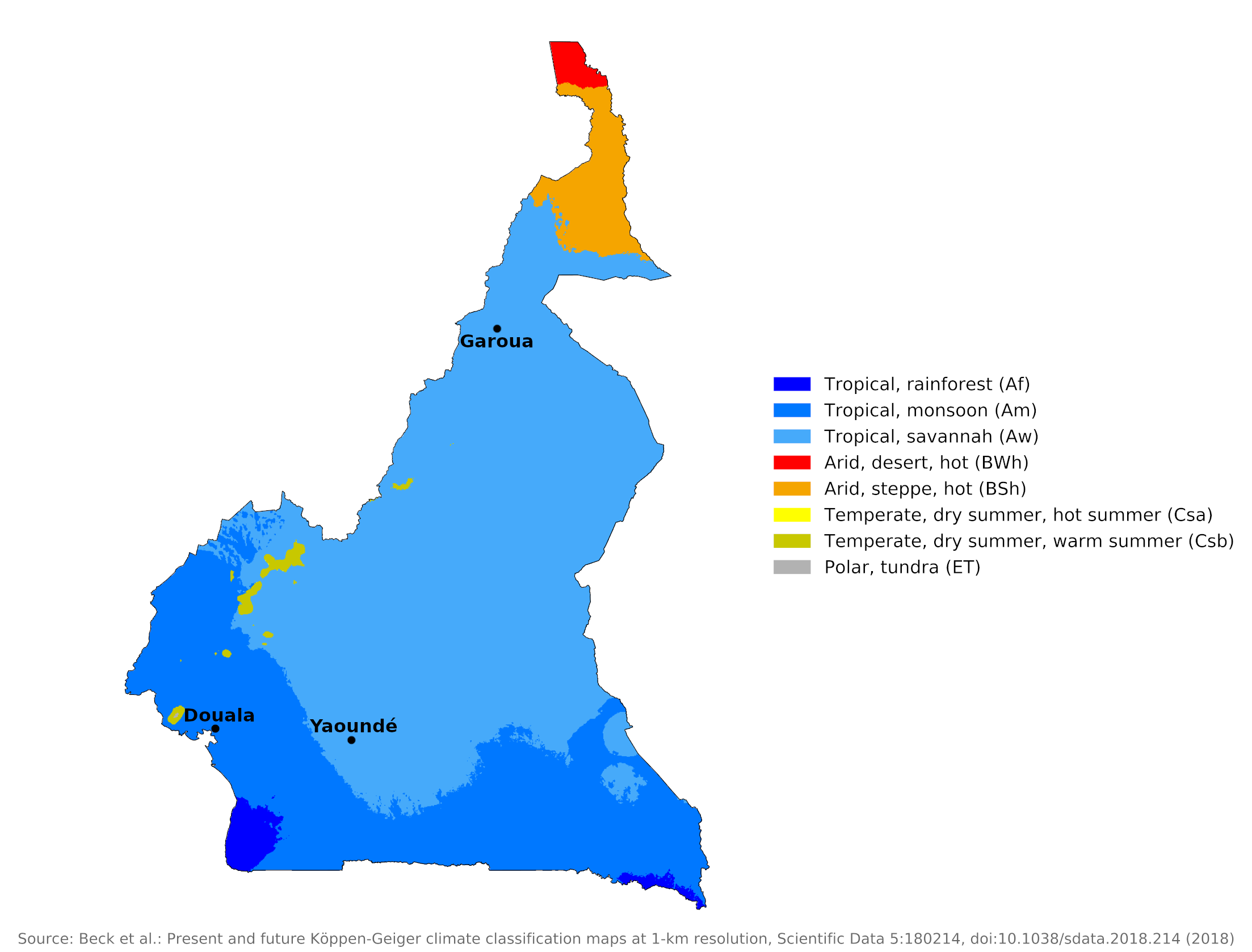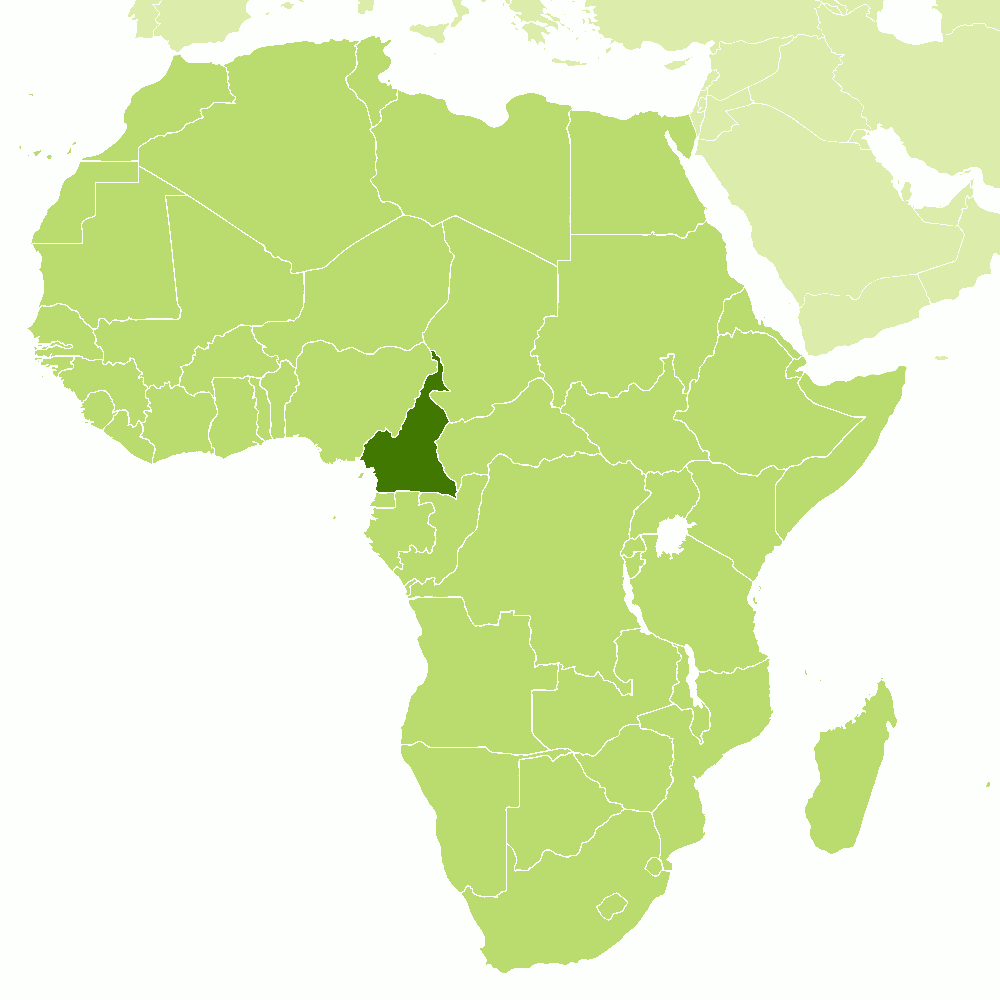The Climate of
Cameroon
 Countryside near Brouwi, in the north of Cameroon
Countryside near Brouwi, in the north of Cameroon
Climate Map
 Climate map of Cameroon
Climate map of Cameroon
What is the climate of Cameroon like?
Cameroon is a Central African country about the size of France and located north of the equator. It has a short coastline on the Gulf of Guinea but borders Nigeria on the west, Chad on the north, the Central African Republic on the east, and Congo and Gabon on the south. The southern and northern regions of the country are two different climate zones.
Cameroon lies entirely in the tropics and has a characteristic tropical climate. The extremes in rainfall are notable: from barely enough rainfall to support agriculture in the extreme north near Chad, to over 5,000 millimters (200 inches) annually in the southwest around Mount Cameroon. There is no single rainfall pattern. In the north the rainy season is May through September. In the south and around Douala, light rains in March and April are followed by heavy rains from May to mid-November. There is less rainfall in Yaounde than in Douala but the pattern is the same except that in July, when Douala is receiving daily drenching rains, Yaounde has a dry spell.
July to October are the coolest months and also bring the most rain. On the coast, average annual rainfall is between 2,500 and 4,000 millimeters (100 and 160 inches); in the southern inland between 1,500 and 2,500 millimeters (60 and 100 inches). The climate of Yaoundé is typical of the southern part of the country.
| Climate data for Yaoundé | |||||||||||||
|---|---|---|---|---|---|---|---|---|---|---|---|---|---|
| Month | Jan | Feb | Mar | Apr | May | Jun | Jul | Aug | Sep | Oct | Nov | Dec | Year |
| Average high °C (°F) | 29.6 (85.3) | 31.0 (87.8) | 30.4 (86.7) | 29.6 (85.3) | 28.8 (83.8) | 27.7 (81.9) | 26.5 (79.7) | 26.5 (79.7) | 27.5 (81.5) | 27.8 (82.0) | 28.1 (82.6) | 28.5 (83.3) | 28.5 (83.3) |
| Daily mean °C (°F) | 24.6 (76.3) | 25.7 (78.3) | 25.4 (77.7) | 25.0 (77.0) | 24.5 (76.1) | 23.8 (74.8) | 23.2 (73.8) | 22.9 (73.2) | 23.4 (74.1) | 23.5 (74.3) | 23.9 (75.0) | 24.0 (75.2) | 24.2 (75.6) |
| Average low °C (°F) | 19.6 (67.3) | 20.3 (68.5) | 20.3 (68.5) | 20.3 (68.5) | 20.2 (68.4) | 19.9 (67.8) | 19.9 (67.8) | 19.3 (66.7) | 19.3 (66.7) | 19.2 (66.6) | 19.6 (67.3) | 19.5 (67.1) | 19.8 (67.6) |
| Average precipitation mm (inches) | 19.0 (0.75) | 42.8 (1.69) | 124.9 (4.92) | 171.3 (6.74) | 199.3 (7.85) | 157.1 (6.19) | 74.2 (2.92) | 113.7 (4.48) | 232.3 (9.15) | 293.6 (11.56) | 94.3 (3.71) | 18.6 (0.73) | 1,541.1 (60.69) |
| Source: World Meteorological Organization | |||||||||||||
The northern part of Cameroon has a drier and therefore more pleasant climate. It has a single rainy season between April and September at the time of high sun and a distinct dry season during the rest of the year. Total annual precipitation falls from 1,500 millimeters (60 inches) per year in the central plateau to 600 millimeters (24 inches) in the north near Lake Chad, and the average temperature ranges from 23° to 26°C (73° to 79°F). although it can exceed 40°C (104°F) in the far north. The dry season in the north lasts from October to March. The climate of Garoua is typical of the northern part of the country.
| Climate data for Garoua | |||||||||||||
|---|---|---|---|---|---|---|---|---|---|---|---|---|---|
| Month | Jan | Feb | Mar | Apr | May | Jun | Jul | Aug | Sep | Oct | Nov | Dec | Year |
| Average high °C (°F) | 34.4 (93.9) | 37.3 (99.1) | 39.8 (103.6) | 39.5 (103.1) | 36.5 (97.7) | 33.2 (91.8) | 31.1 (88.0) | 30.7 (87.3) | 31.5 (88.7) | 34.2 (93.6) | 36.0 (96.8) | 34.8 (94.6) | 34.9 (94.8) |
| Daily mean °C (°F) | 26.0 (78.8) | 28.9 (84.0) | 32.2 (90.0) | 33.0 (91.4) | 30.7 (87.3) | 28.2 (82.8) | 26.6 (79.9) | 26.4 (79.5) | 26.7 (80.1) | 28.1 (82.6) | 27.3 (81.1) | 26.0 (78.8) | 28.3 (82.9) |
| Average low °C (°F) | 17.5 (63.5) | 20.5 (68.9) | 24.7 (76.5) | 26.4 (79.5) | 24.9 (76.8) | 23.2 (73.8) | 22.2 (72.0) | 22.0 (71.6) | 21.9 (71.4) | 22.2 (72.0) | 19.2 (66.6) | 17.3 (63.1) | 21.8 (71.2) |
| Average precipitation mm (inches) | 0.0 (0.0) | 0.0 (0.0) | 2.0 (0.08) | 44.1 (1.74) | 108.4 (4.27) | 134.8 (5.31) | 205.3 (8.08) | 247.9 (9.76) | 190.0 (7.48) | 63.3 (2.49) | 1.6 (0.06) | 0.0 (0.0) | 997.4 (39.27) |
| Source: NOAA | |||||||||||||
Douala on the coast shows the much heavier annual rainfall here and the particularly wet period between June and October. This is a result of exposure to the humid southwest winds of the Guinea monsoon, which are lifted as they meet the high peak of Mount Cameroon. A small area of the mountain is one of three places in the world with an average annual rainfall of over 10,000 millimeters (400 inches). (The other places are in the Hawaiian Islands and Assam in India).
| Climate data for Douala | |||||||||||||
|---|---|---|---|---|---|---|---|---|---|---|---|---|---|
| Month | Jan | Feb | Mar | Apr | May | Jun | Jul | Aug | Sep | Oct | Nov | Dec | Year |
| Average high °C (°F) | 32.2 (90.0) | 32.8 (91.0) | 32.5 (90.5) | 32.1 (89.8) | 31.4 (88.5) | 29.9 (85.8) | 28.1 (82.6) | 27.7 (81.9) | 29.0 (84.2) | 29.8 (85.6) | 30.9 (87.6) | 31.7 (89.1) | 30.7 (87.3) |
| Daily mean °C (°F) | 27.8 (82.0) | 28.5 (83.3) | 28.2 (82.8) | 27.8 (82.0) | 27.3 (81.1) | 26.5 (79.7) | 25.4 (77.7) | 25.3 (77.5) | 25.9 (78.6) | 26.2 (79.2) | 27.1 (80.8) | 27.5 (81.5) | 27.0 (80.6) |
| Average low °C (°F) | 23.4 (74.1) | 24.1 (75.4) | 23.9 (75.0) | 23.5 (74.3) | 23.2 (73.8) | 23.0 (73.4) | 22.7 (72.9) | 22.8 (73.0) | 22.8 (73.0) | 22.5 (72.5) | 23.2 (73.8) | 23.3 (73.9) | 23.2 (73.8) |
| Average precipitation mm (inches) | 34.2 (1.35) | 54.5 (2.15) | 155.2 (6.11) | 241.2 (9.50) | 276.2 (10.87) | 354.1 (13.94) | 681.4 (26.83) | 687.5 (27.07) | 561.2 (22.09) | 406.6 (16.01) | 123.1 (4.85) | 27.5 (1.08) | 3,602.7 (141.84) |
| Source: World Meteorological Organization | |||||||||||||
References
- E. A. Pearce, Charles Gordon Smith, (1990) The Hutchinson World Weather Guide, John Murray Press. ISBN 1859863426
- Timothy L. Gall, (ed.), (2003), Worldmark Encyclopedia of the Nations, Eleventh Edition, Thomson Gale
- Peace Corps of the United States. ERIC ED369711: (1993). Destination: Cameroon. Study Guide.
- Hugh Chisholm, (ed.), (1911), Encyclopædia Britannica, Eleventh edition, Cambridge University Press
The Climate of
Cameroon

In summary:
Cameroon has a climate that varies from tropical along the coast to semiarid and hot in the north. The southern and northern regions of the country are two distinct climatic areas.
The south alternates between wet and dry seasons. The two wet seasons are from March to June and again from August to November. Annual precipitation in the south reaches 4000 millimeters (160 inches). The north part of Cameroon has a single wet season between April and September with an average annual precipitation between 1000 and 1750 millimeters (39 and 69 inches).